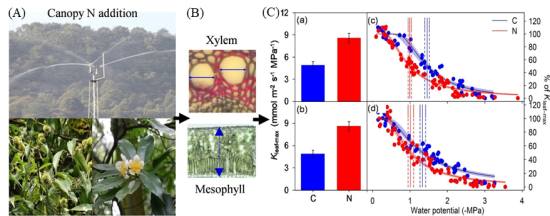SCBG researchers reveal responses of plant water relations to canopy nitrogen addition in a subtropical forest
Much effort has gone into a mechanistic understanding of how atmospheric nitrogen (N) deposition may affect plant growth via nutritional status and photosynthesis, but the possible involvement of hydraulically mediated responses, especially those of leaf hydraulics remains unclear.
In a recent article published in Science of the Total Environment, a research group led by Professor YE Qing at South China Botanical Garden of Chinese Academy of Sciences, has made advances in understanding the mechanisms of plant water relations in response to N deposition.
The researchers investigated responses of leaf water relations and morphological and anatomical traits of two dominant tree species (Castanopsis chinensis and Schima superba) to a six-year canopy N addition in a subtropical forest (Figure). They found that canopy N addition increased leaf hydraulic conductance of the two dominant tree species, due to the increase of vessel lumen breath and the reduction of leaf thickness, whereas plants showed less resistance to drought stresses, because of decreased conduit reinforcement and increased leaf thickness shrinkage.
It was concluded that N deposition may lead to increases of plant water loss to the atmosphere as well as tree vulnerability to drought.
For further reading, please refer to: https://doi.org/10.1016/j.scitotenv.2021.145415.

Figure. Canopy N spraying and the studied species (A), measurements of leaf midrib conduit anatomy and leaf thickness (B) and responses of leaf hydraulic traits to N addition (C).
File Download: